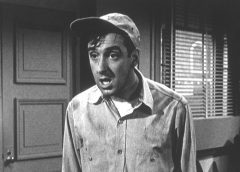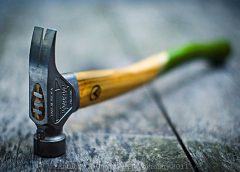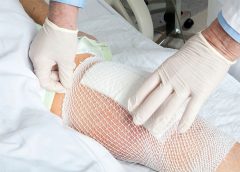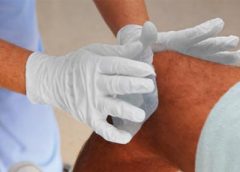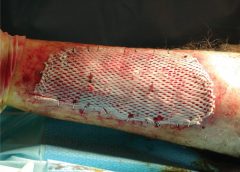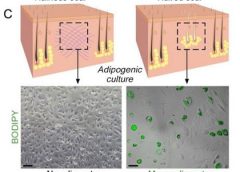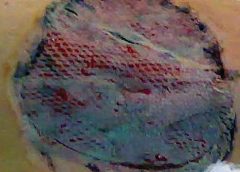BY: NANCY MORGAN, RN, BSN, MBA, WOCN, WCC, CWCMS, DWC
Support surfaces are geared for managing our patients’ tissue load and redistributing it to prevent skin breakdown. There are three types of pressure redistribution mattresses available, classified as group 1, group 2, and group 3. Group 1 mattresses lack a power source and maintain a constant state of inflation. They include foam mattresses, gel mattresses, and air mattresses. Group 2 support surfaces, such as powered, low-air-loss, and alternating pressure mattresses use inflation and deflation to spread the tissue load over a large surface area. Group 3 mattresses include the air-fluidized mattress, a special type of powered mattress that provides the highest-pressure redistribution via a fluid-like medium created by forcing air through beads, as characterized by immersion and envelopment. (more…)
Search Results for: cin
Measuring wounds
BY: NANCY MORGAN, RN, BSN, MBA, WOCN, WCC, CWCMS, DWC
An essential part of weekly wound assessment is measuring the wound. It’s vitally important to use a consistent technique every time you measure. The most common type of measurement is linear measurement, also known as the “clock” method. In this technique, you measure the longest length, greatest width, and greatest depth of the wound, using the body as the face of an imaginary clock. Document the longest length using the face of the clock over the wound bed, and then measure the greatest width. On the feet, the heels are always at 12 o’clock and the toes are always 6 o’clock. Document all measurements in centimeters, as L x W x D. Remember—sometimes length is smaller than width. (more…)
Jim Nabors Would Just Cry
by Dr. Michael Miller
For those of you not as familiar with the Hoosier State as you should be, I used to think it was essentially paradise. Jim Nabors of Gomer Pyle fame is our ubiquitous, tuneful icon with his always well-received “Back Home in Indiana” as a mantra to that source of pride. Our former Governor “My Man” Mitch Daniels was a genius who, using a combination of intelligence, common sense and the persuasive powers of a midwest Svengali, created an economic model that our neighbors can only lust after. Our medicolegal climate is among the best in the US and well it should be. However, while there are some extraordinary caregivers and facilities here, a recent US News and World Report curiously showed that almost none of our hospitals made their “Best of” lists in any category. That is not to say there is bad care but to not have a single facility in an entire state even achieve an honorable mention gives one pause to reflect. The State newspapers were notoriously quiet on this concerning fact despite their trumpeting of who does what well, when and where. (more…)
Read MoreHole-ier than Thou, Evidence Based Regardless of the Evidence
by Dr. Michael Miller
There are certain phrases that make the hair on the back of my neck stand up. Someone telling me that they are a good Jew, a good Christian, a good Muslim or the ultimate in self serving lies, “I ONLY practice EVIDENCE BASED MEDICINE”. People who are what they claim they are do not need to announce it. A short conversation, watching them work, others opinions about them all answer the question before it is asked. Like the RN who asked for a recent presentation on the true science behind NPWT (no, you don’t really understand it). She made sure to tell me not only that she practiced only EVIDENCE BASED MEDICINE but then gave me several examples which incidentally had absolutely no scientific evidence (save for articles from lots of dabblers doing lots of crazy things to people and writing about them). I am now awaiting her response as she may have to realize that her version of EVIDENCE BASED is no more real than Kim Kardashian’s celebrity. (more…)
Read MoreIf All You Have is a Hammer, What Happens When You Run Out of Nails?
by Dr. Michael Miller
Over the years of making house calls for wound care, I found that there was a real need for home based mental health and behavioral care, palliative care, podiatry and lots of other things. We cater to those who are home bound based on the classic definition involving the word “Taxing”. One of the more prevalent problems affecting all patients involves the nebulous but ubiquitous, nerve jangling, aptly named, “5th Vital Sign”, namely pain. As a part of my medical group, we have created a program that provides pain management not just to the home bound but all those whose lives and lifestyles are affected adversely by it. The program is a monument to government bureaucracy involving multiple layers of paperwork, mental health evaluations, testing of bodily fluids for both illegal and legal substances and then, the actual evaluation of the patient commences. After all hurdles are vetted and then jumped, then and only then does a prescription for the appropriate nostrum leave the pad. In wound care, we treat based on the etiology, the location, the related factors, the amounts of drainage, the surrounding tissues and so on, ad nauseum. Not surprisingly, in pain management, the scenario is much different. In wound care the mantra of the dabbler is see the hole, fill the hole. In pain management, the goal is to minimize pain to maximize functionality but the overriding questions are how this is accomplished. (more…)
Read MoreHelp Me, Help Me, Help Me…next Tuesday
by Dr. Michael Miller
Health care providers are by nature an altruistic bunch. I have the honor of interviewing potential entries to my beloved profession as part of the admissions process at the newest Osteopathic Medical School in Indiana, Marian University. The process is unique in that it does not simply ask the age old questions of “Why you want to be a physician ?”, (“Because I want to do primary care in a rural area”). No, our probing involves scenarios in which they have to look at a social situation, identify their thoughts, those of the opposing views and then cohesively demonstrate intelligence, confidence, logical thought processes and humanity…all in an 8 minute period repeated 7 times. Their responses juxtaposed against what I see in my day to day always gives me pause to think about how the practice of medicine has been so perverted by the promotion of self abdication of responsibility. The “let your government do it for you” mantras and newest politically correct definitions of disabled (encompassing everything from melancholia to dislike of red M and M’s) have resulted in a major paradigm shift in medicine. Whereas, the hospitals once touted their ability to heal all manner of maladies, they now recognize their cost ineffectiveness, more detrimental than beneficial care (just check the nutritional parameters of anyone pre and post hospitalization) and the downright danger of going to one, unless you are a burgeoning superbug. (more…)
Read MoreAlternate universes – Einstein’s insanity
I remain absolutely amazed that there are so many people doing the same thing and yet doing it so completely different. Depending on where a patient’s wound care and orders originate from, the care I try to translate from that starting point is always a combination of dressing regimens worthy of computer code in their simplicity. The only thing usually missing is the diagnosis. It’s as though they come from an identical planet in an alternate universe.
The issue is that there is the complete dissociation of what is done for a given wound care problem in one practice setting versus another. Having stayed as far away from hospital-based wound care as possible, I continue to be amazed by hospital wound teams touting their expertise while using two to three times a day dressing changes and therapies that are the antithesis of any identifiable evidence. They actually expect entities receiving their cases (including home healthcare agencies, LTAC, skilled facilities, and others) to copy the identical care scenario regardless of their widely variable situations. In fact, the only constant is the patient and his or her condition. (more…)
Read MoreBreaking silos: Effective wound healing means treatment across the continuum
Around 6.5 million patients in the U.S. suffer from chronic wounds, such as pressure injuries or ulcers. Treatment costs $25 billion each year, representing a sizable and growing problem. Despite the wide impact of chronic wounds, it’s rare to see specialized, effective wound care delivered across the care continuum.
A chronic non-healing wound is a surrogate marker for illness. These patients require holistic management of their co-morbidities and continuity across care settings.
Despite this, a great deal of emphasis has been placed on treating wounds as singular events, managed topically with expensive dressings and support surfaces. This is only a small part of wound healing.
As a physician focused solely on wound care, I have learned that we must shift the focus from simply treating the wound to treating the wounded patient. The impact in the post-acute care setting in particular is worthy of evaluation and discussion, as up to 29% of patients in long-term care facilities will experience a pressure ulcer, posing serious legal, financial, and staffing implications.
For those providers working outside long-term care, there is little understanding of challenges facing LTC providers. Acute providers do not often ask, for example, how are my LTC partners reimbursed? How are they staffed? What are the requirements and regulatory pressures they face? Asking these questions would facilitate a more productive dialogue with a focus on collaborative prevention, rather than waiting until a chronic wound occurs in the LTC setting.
Creating an integrated wound care community
To address the needs of the present and growing population of patients with chronic wounds, Healogics developed an integrated wound care community model, to coordinate the wound healing process across all care settings. The program utilizes Healogics Specialty Physicians, a subspecialty group of physicians and providers with extensive training solely focused on wound care.
HSPs provide expert inpatient consultation and ensure safe transition of patients out of the hospital into the appropriate care setting. Because HSPs see the patient regardless of post-discharge venue, patients receive the same quality of care whether they are going home, to a skilled-nursing, assisted living, or LTC setting. Because chronic wounds are surrogate markers for illness, we have realized it’s essential to have an integrated, multi-setting, and multi-disciplinary process to treat the patient and their co-morbidities.
Data collected at a pilot IWCC site in the Midwestern U.S. from 2014 to 2016 revealed very positive trends for chronic wound patients. In the acute care setting, the average length of stay decreased from 9.41 days to 5.64 days, and total cost of care per patient was reduced from $10,670 to $7,248.
We’re excited by these promising results, which were revealed at the American College of Wound Healing and Tissue Repair Conference last December. We look forward to refining and expanding the model by helping our partners in acute and LTC settings standardize their practices, use evidence-based clinical guidelines, mobilize technologies and processes, and pay critical attention to patient safety and value-based outcomes.
When it comes to wound healing, no venue of care should operate alone—an integrated solution that creates continuity for the patient is critical. There are four things LTC facilities can do to break down the silos:
Read more at McKnight’s
Read MoreBetter Skin Grafts – take only one layer
Research shows that a skin-graft harvesting system aids chronic wound recovery and reduces care costs by accelerating the healing process.
More than six million cases of chronic wounds cost $20 billion each year in the United States. Diabetic ulcers, pressure sores, surgical site wounds, and traumatic injuries to high-risk patients account for most wounds that won’t heal. (more…)
Read MoreUsing fat to help wounds heal without scars
Philadelphia – Doctors have found a way to manipulate wounds to heal as regenerated skin rather than scar tissue. The method involves transforming the most common type of cells found in wounds into fat cells – something that was previously thought to be impossible in humans. Researchers began this work at the Perelman School of Medicine at the University of Pennsylvania, which led to a large-scale, multi-year study in connection with the Plikus Laboratory for Developmental and Regenerative Biology at the University of California, Irvine. They published their findings online in the journal Science on Thursday, January 5th, 2017.Fat cells called adipocytes are normally found in the skin, but they’re lost when wounds heal as scars. The most common cells found in healing wounds are myofibroblasts, which were thought to only form a scar. Scar tissue also does not have any hair follicles associated with it, which is another factor that gives it an abnormal appearance from the rest of the skin. Researchers used these characteristics as the basis for their work – changing the already present myofibroblasts into fat cells that do not cause scarring. (more…)
Read MoreSkin substitutes: Understanding product differences
Skin substitutes (also called tissuebased products and dermal replacements) are a boon to chronic wound management when traditional therapies have failed. When selecting skin substitutes for their formularies, wound care professionals have many product options—and many decisions to make.
Repair of skin defects has been a pressing concern for centuries. As early as the 15th century BC, Egyptian physicians chronicled procedures and herbal treatments to heal wounds, including xenografts (skin from another species). The practice of applying allografts (human cadaver skin) to wounds was first documented in 1503. In 1871, autologous skin grafting (skin harvested from the the person with the wound) was tried. Next came epithelial- cell seeding, which involves scraping off the superficial epithelium of healthy skin and transplanting the cells onto the wound. (more…)
Read MoreFrequently asked questions about support surfaces
The National Pressure Ulcer Advisory Panel (NPUAP) describes support surfaces as “specialized devices for pressure redistribution designed for management of tissue loads, microclimate, and/or other therapeutic functions.” These devices include specialized mattresses, mattress overlays, chair cushions, and pads used on transport stretchers, operating room (OR) tables, examination or procedure tables, and gurneys. Some support surfaces are part of an integrated bed system, which combines the bed frame and support surface into a single unit. (more…)
Read More
